Middleton W.M. (ed.) Reference Data for Engineers: Radio, Electronics, Computer and Communications
Подождите немного. Документ загружается.

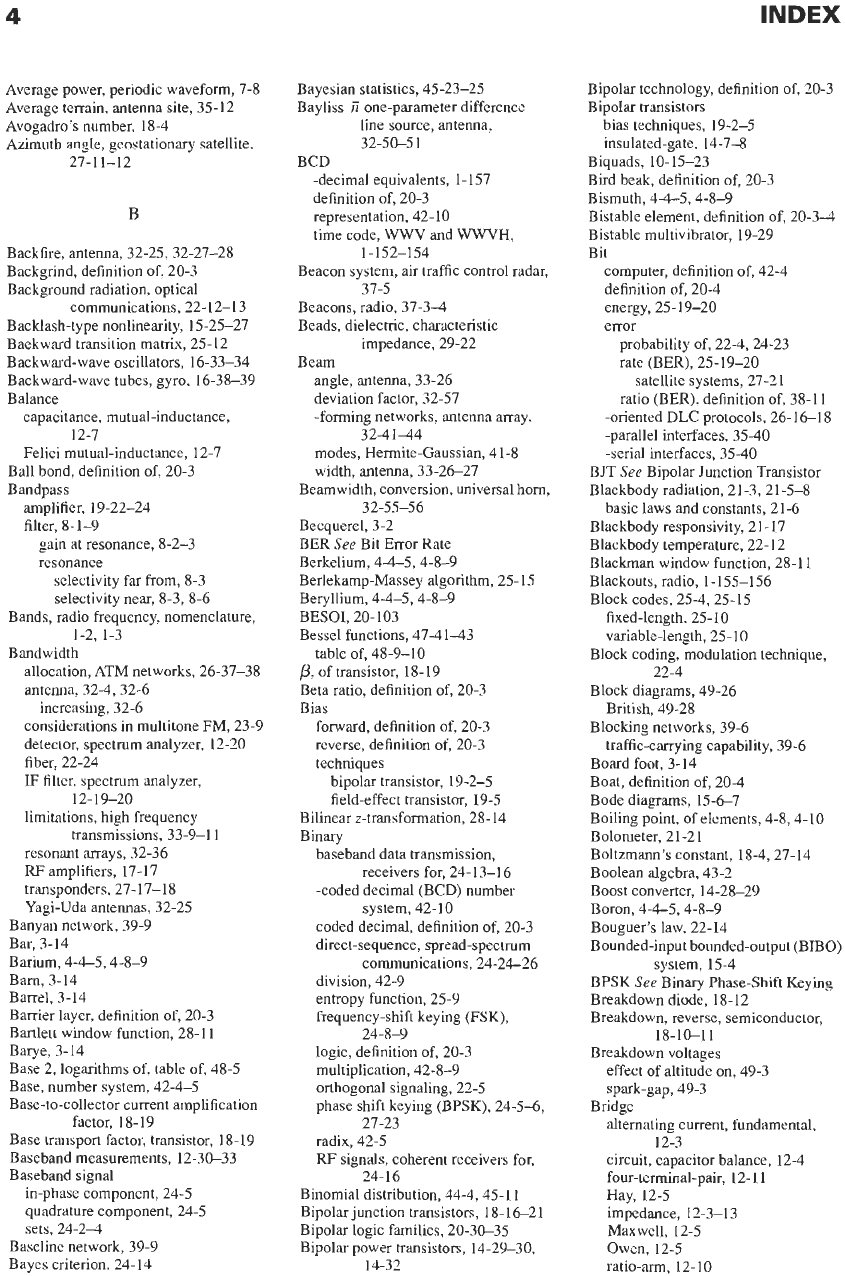
Average power, periodic waveform, 7-8
Average terrain, antenna site, 35-12
Avogadro‘s number, 18-4
Azimuth angle, geostationary satellite,
27-11-12
B
Backfire, antenna, 32-25,32-27-28
Backgrind, definition of, 20-3
Background radiation, optical
communications, 22-1 2-1 3
Backlash-type nonlinearity, 15-25-27
Backward transition matrix, 25-12
Backward-wave oscillators, 16-33-34
Backward-wave tubes, gyro, 16-38-39
Balance
capacitance, mutual-inductance,
Felici mutual-inductance, 12-7
12-7
Ball bond, definition of, 20-3
B andpass
amplifier, 19-22-24
filter, 8-1-9
gain at resonance, 8-2-3
resonance
selectivity far from, 8-3
selectivity near, 8-3,8-6
Bands, radio frequency, nomenclature,
Bandwidth
1-2, 1-3
allocation, ATM networks, 26-37-38
antenna, 32-4,32-6
increasing, 32-6
considerations in multitone
FM,
23-9
detector, spectrum analyzer, 12-20
fiber, 22-24
IF
filter, spectrum analyzer,
limitations, high frequency
resonant arrays, 32-36
RF
amplifiers, 17-17
transponders, 27- 17-1
8
Yagi-Uda antennas, 32-25
12- 19-20
transmissions, 33-9-1 1
Banyan network, 39-9
Barium, 4-4-5,4-8-9
Barn, 3-14
Barrel, 3-14
Barrier layer, definition of, 20-3
Bartlett window function, 28-11
Barye, 3-14
Base 2, logarithms
of,
table of, 48-5
Base, number system, 42-4-5
Base-to-collector current amplification
Base transport factor, transistor, 18-19
Baseband measurements, 12-30-33
Baseband signal
Bar, 3-14
factor, 18-19
in-phase component, 24-5
quadrature component, 24-5
sets, 24-2-4
Baseline network, 39-9
Bayes criterion, 24-14
Bayesian statistics, 45-23-25
Bayliss
ii
one-parameter difference
line
source, antenna,
32-50-51
BCD
-decimal equivalents, 1-157
definition of, 20-3
representation, 42-10
time code,
WWV
and
WWVH,
1-152-154
Beacon system, air traffic control radar,
37-5
Beacons, radio, 37-3-4
Beads, dielectric, characteristic
Beam
impedance, 29-22
angle, antenna, 33-26
deviation factor, 32-57
-forming networks, antenna array,
modes, Hermite-Gaussian, 41-8
width, antenna, 33-26-27
32-55-56
32-4 144
Beamwidth, conversion, universal
horn,
Becquerel, 3-2
BER
See
Bit Error Rate
Berkelium, 4-4-5,4-8-9
Berlekamp-Massey algorithm, 25-15
Beryllium, 4-4-5,4-8-9
Bessel functions, 47-4143
table of, 48-9-10
p,
of transistor, 18-19
Beta ratio, definition of, 20-3
Bias
forward, definition of, 20-3
reverse, definition of, 20-3
techniques
BESOI, 20-103
bipolar transistor, 19-2-5
field-effect transistor, 19-5
Bilinear z-transformation, 28-14
Binary
baseband data transmission,
receivers for, 24-13-16
-coded decimal (BCD) number
system, 42-10
coded decimal, definition of, 20-3
direct-sequence, spread-spectrum
communications, 24-24-26
division, 42-9
entropy function, 25-9
frequency-shift keying
(FSK),
24-8-9
logic, definition
of,
20-3
multiplication, 42-8-9
orthogonal signaling, 22-5
phase shift keying (BPSK), 24-5-6,
radix, 42-5
W
signals, coherent receivers for,
27-23
24-16
Binomial distribution, 44-4,4511
Bipolar junction transistors, 18-16-21
Bipolar logic families, 20-30-35
Bipolar power transistors, 14-29-30,
14-32
Bipolar technology, definition of, 20-3
Bipolar transistors
bias techniques, 19-2-5
insulated-gate, 14-7-8
Biquads, 10-15-23
Bird beak, definition
of,
20-3
Bismuth, 4-4-5,4-8-9
Bistable element, definition of, 20-3-4
Bistable multivibrator, 19-29
Bit
computer, definition of, 42-4
definition of, 20-4
energy, 25-19-20
error
probability of, 22-4,24-23
rate (BER), 25-19-20
ratio (BER). definition of, 38-11
-oriented
DLC
protocols, 26-16-18
-parallel interfaces, 35-40
-serial interfaces, 35-40
satellite systems, 27-21
BJT See Bipolar Junction Transistor
Blackbody radiation, 21-3,21-5-8
basic laws and constants, 21-6
Blackbody responsivity, 21-17
Blackbody temperature, 22-12
Blackman window function, 28-1
1
Blackouts, radio, 1-155-156
Block codes, 25-4,25-15
fixed-length. 25-10
variable-length, 25-10
Block coding, modulation technique,
22-4
Block diagrams, 49-26
Blocking networks, 39-6
British, 49-28
traffic-carrying capability, 39-6
Board foot, 3-14
Boat, definition
of,
20-4
Bode diagrams, 15-6-7
Boiling point, of elements, 4-8,4-10
Bolometer, 21-21
Boltzmann’s constant, 18-4, 27-14
Boolean algebra, 43-2
Boost converter, 14-28-29
Boron, 4-4-5,4-8-9
Bouguer’s law, 22-14
Bounded-input bounded-output (BIBO)
BPSK
See
Binary Phase-Shift
Keying
Breakdown diode, 18-12
Breakdown, reverse, semiconductor,
18-10-11
Breakdown voltages
effect of altitude
on,
49-3
spark-gap, 49-3
alternating current, fundamental,
circuit, capacitor balance, 12-4
four-terminal-pair, 12-1
1
Hay, 12-5
impedance, 12-3-13
Maxwell, 12-5
Owen, 12-5
ratio-arm, 12-10
system, 15-4
Bridge
12-3
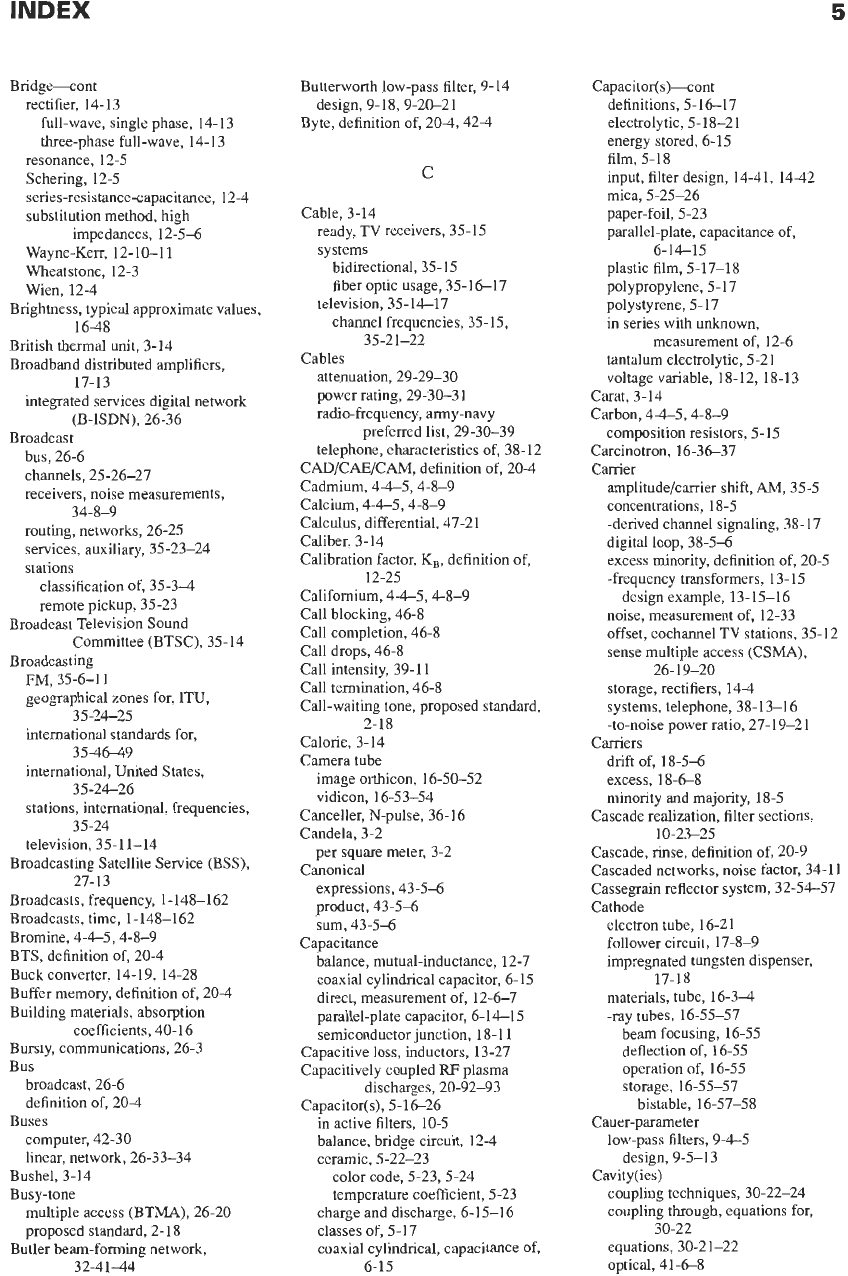
5
Bridge--cont
rectifier, 14-13
full-wave, single phase, 14-13
three-phase full-wave, 14-13
resonance, 12-5
Schering, 12-5
series-resistance-capacitance, 12-4
substitution method, high
impedances, 12-54
Wayne-Ken-, 12-10-1
1
Wheatstone, 12-3
Wien, 12-4
Brightness, typical approximate values,
British thermal unit, 3-14
Broadband distributed amplifiers,
17-13
16-48
integrated services digital network
(B-ISDN), 26-36
Broadcast
bus, 26-6
channels, 25-26-27
receivers, noise measurements,
routing, networks, 26-25
services, auxiliary, 35-23-24
stations
classification of, 35-34
remote pickup, 35-23
34-8-9
Broadcast Television Sound
Broadcasting
Committee (BTSC), 35-14
FM, 35-6-1
1
geographical zones for, ITU,
international standards for,
international, United States,
stations, international, frequencies,
35-24
television, 35-1 1-14
27-13
35-24-25
35-4649
35-24-26
Broadcasting Satellite Service (BSS),
Broadcasts, frequency, 1-148-162
Broadcasts, time, 1-148-162
Bromine, 4-45,4-8-9
BTS, definition of, 20-4
Buck converter, 14-19, 14-28
Buffer memory, definition of, 20-4
Building materials, absorption
Bursty, communications, 26-3
Bus
coefficients, 40-16
broadcast, 26-6
definition of, 20-4
computer, 42-30
linear, network, 26-33-34
Buses
Bushel, 3-14
Busy-tone
multiple access (BTMA), 26-20
proposed standard, 2-18
Butler beam-forming network,
32-41-44
Butterworth low-pass filter, 9-14
Byte, definition of, 20-4,42-4
design, 9-18,9-20-21
C
Cable, 3-14
ready, TV receivers, 35-15
systems
bidirectional, 35-15
fiber optic usage, 35-16-17
channel frequencies, 35-15,
television, 35-14-17
35-21-22
Cables
attenuation, 29-29-30
power rating, 29-30-31
radio-frequency, army-navy
telephone, characteristics of, 38-12
CAD/CAE/CAM, definition of, 20-4
Cadmium, 4-4-5,4-8-9
Calcium, 4-4-5,4-8-9
Calculus, differential, 47-21
Caliber, 3-14
Calibration factor, KB, definition of,
12-25
Californium, 4-4-5,4-8-9
Call blocking, 46-8
Call completion, 46-8
Call drops, 46-8
Call intensity, 39-11
Call termination, 46-8
Call-waiting tone, proposed standard,
Calorie, 3-14
Camera tube
preferred list, 29-30-39
2-18
image orthicon, 16-50-52
vidicon, 16-53-54
Canceller, N-pulse, 36-16
Candela, 3-2
per square meter, 3-2
Canonical
expressions, 43-5-6
product, 43-5-6
sum, 43-5-6
balance, mutual-inductance, 12-7
coaxial cylindrical capacitor, 6-15
direct, measurement of, 12-6-7
parallel-plate capacitor, 6-14-1 5
semiconductor junction, 18-1
1
Capacitive loss, inductors, 13-27
Capacitively coupled
RF
plasma
Capacitor(s), 5-16-26
Capacitance
discharges, 20-92-93
in active filters, 10-5
balance, bridge circuit, 12-4
ceramic, 5-22-23
color code, 5-23,524
temperature coefficient, 5-23
charge and discharge, 6-15-16
classes of, 5-17
coaxial cylindrical, capacitance of,
6-15
Capacitor( s)-cont
definitions, 5- 16-17
electrolytic, 5-1 8-21
energy stored, 6-15
film, 5-18
input, filter design, 14-41, 14-42
mica, 5-25-26
paper-foil, 5-23
parallel-plate, capacitance of,
plastic film, 5-17-18
polypropylene, 5-17
polystyrene, 5-17
in series with
unknown,
tantalum electrolytic, 5-21
voltage variable, 18-12, 18-13
6-14-15
measurement of, 12-6
Carat, 3-14
Carbon, 4-4-5,4-8-9
Carcinotron, 16-36-37
Carrier
composition resistors, 5-15
amplitude/carrier shift,
AM,
35-5
concentrations, 18-5
-derived channel signaling, 38-17
digital loop, 38-54
excess minority, definition of, 20-5
-frequency transformers, 13-15
design example, 13-15-16
noise, measurement of, 12-33
offset, cochannel TV stations, 35-12
sense multiple access (CSMA),
26-19-20
storage, rectifiers, 14-4
systems, telephone, 38- 13-16
-to-noise power ratio, 27-19-21
drift of, 18-54
excess, 18-6-8
minority and majority, 18-5
Carriers
Cascade realization, filter sections,
Cascade, rinse, definition of, 20-9
Cascaded networks, noise factor, 34-1 1
Cassegrain reflector system, 32-54-57
Cathode
10-23-25
electron tube, 16-21
follower circuit, 17-8-9
impregnated tungsten dispenser,
materials, tube, 16-34
-ray tubes, 16-55-57
17-18
beam focusing, 16-55
deflection
of,
16-55
operation of, 16-55
storage, 16-55-51
bistable, 16-57-58
Cauer-parameter
low-pass filters, 9-4-5
design, 9-5-13
Cavity(ies)
coupling techniques, 30-22-24
coupling through, equations for,
30-22
equations, 30-21-22
optical, 41-6-8
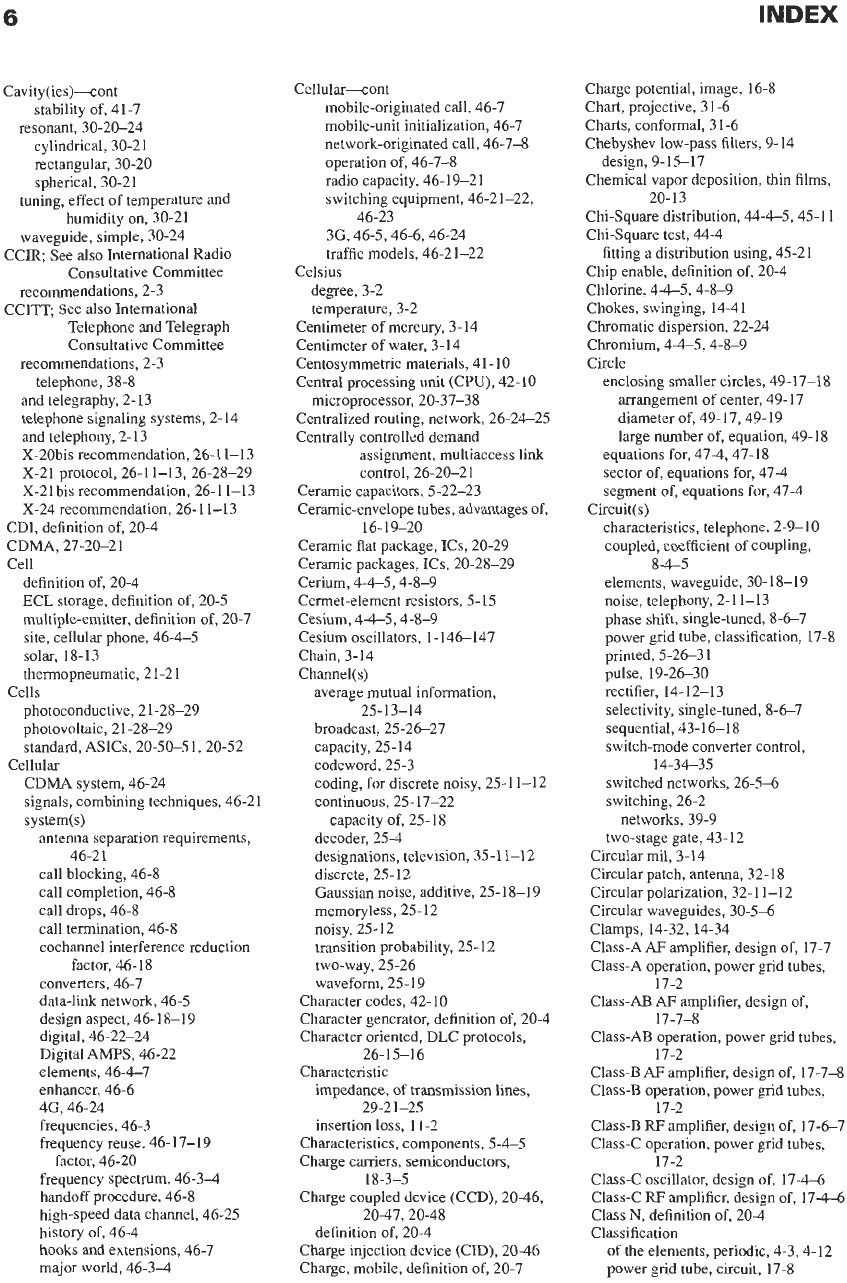
Cavity(ies)--cont
stability of, 41-7
resonant, 30-20-24
cylindrical, 30-21
rectangular, 30-20
spherical, 30-21
tuning, effect of temperature and
humidity on, 30-21
waveguide, simple, 30-24
CCIR;
See
also International Radio
Consultative Committee
recommendations, 2-3
CCITT,
See
also International
Telephone and Telegraph
Consultative Committee
recommendations, 2-3
telephone, 38-8
and telegraphy, 2-13
telephone signaling systems, 2-14
and telephony, 2-13
X-20bis
recommendation, 26-1 1-13
X-21 protocol, 26-11-13,26-28-29
X-2lbis recommendation, 26-1 1-13
X-24 recommendation, 26-1 1-13
CDI, definition
of,
20-4
Cell
CDMA, 27-20-21
definition of, 20-4
ECL storage, definition of, 20-5
multiple-emitter, definition of, 20-7
site, cellular phone, 46-4-5
thermopneumatic, 21-21
photoconductive, 21 -28-29
photovoltaic, 21 -28-29
solar, 18-13
Cells
standad, ASICS, 20-50-51,20-52
Cellular
CDMA system, 46-24
signals, combining techniques, 46-21
system(s)
antenna separation requirements,
call blocking, 46-8
call completion, 46-8
call drops, 46-8
call termination, 46-8
cochannel interference reduction
factor, 46-18
converters, 46-7
data-link network, 46-5
design aspect, 46-18-19
digital, 46-22-24
Digital AMPS, 46-22
elements, 46-4-7
enhancer, 46-6
4G, 46-24
frequencies, 46-3
frequency reuse, 46-17-19
factor, 46-20
frequency spectrum, 46-3-4
handoff procedure, 46-8
high-speed data channel, 46-25
history of, 46-4
hooks and extensions, 46-7
major world, 46-34
46-21
Cellular--cont
mobile-originated call, 46-7
mobile-unit initialization, 46-7
network-originated call, 46-7-8
operation of, 46-7-8
radio capacity, 46-19-21
switching equipment, 46-21-22,
46-23
3G, 46-5,46-6,46-24
traffic models, 46-21-22
Celsius
degree, 3-2
temperature, 3-2
Centimeter
of
mercury, 3-14
Centimeter
of
water, 3-14
Centosymmetric materials, 41-10
Central processing unit (CPU), 42-10
microprocessor, 20-37-38
Centralized routing, network, 26-24-25
Centrally controlled demand
assignment, multiaccess link
control, 26-20-21
Ceramic capacitors, 5-22-23
Ceramic-envelope tubes, advantages of,
Ceramic flat package,
ICs,
20-29
Ceramic packages, ICs, 20-28-29
Cerium, 4-4-5,4-8-9
Cermet-element resistors, 5-15
Cesium, 4-4-5,4-8-9
Cesium oscillators, 1-146-147
Chain, 3-14
Channel(s)
16-19-20
average mutual information,
broadcast, 25-26-27
capacity, 25-14
codeword, 25-3
coding, for discrete noisy, 25-1 1-12
continuous, 25-17-22
capacity of, 25-18
decoder, 25-4
designations, television, 35-1
1-12
discrete, 25-12
Gaussian noise, additive, 25-18-19
memoryless, 25-12
noisy, 25-12
transition probability, 25-12
two-way, 25-26
waveform, 25-19
Character codes, 42-10
Character generator, definition
of,
20-4
Character oriented, DLC protocols,
Characteristic
25- 13-14
26- 15-16
impedance,
of
transmission lines,
insertion
loss,
11-2
29-2 1-25
Characteristics, components, 5-4-5
Charge carriers, semiconductors,
Charge coupled device (CCD), 20-46,
18-3-5
20-47, 20-48
definition of, 20-4
Charge injection device (CID), 20-46
Charge, mobile, definition of, 20-7
Charge potential, image, 16-8
Chart, projective, 31-6
Charts, conformal, 31-6
Chebyshev low-pass filters, 9-14
Chemical vapor deposition, thin films,
Chi-square distribution, 44-4-5,45-11
Chi-square test, 44-4
fitting a distribution using, 45-21
Chip enable, definition of, 20-4
Chlorine, 4-4-5,4-8-9
Chokes, swinging, 14-41
Chromatic dispersion, 22-24
Chromium, 4-4-5,4-8-9
Circle
design, 9-15-17
20-13
enclosing smaller circles, 49-17-18
arrangement of center, 49-17
diameter of, 49-17,49-19
large number of, equation, 49-18
equations for, 47-4,47-18
sector of, equations for, 47-4
segment of, equations for, 47-4
characteristics, telephone, 2-9-10
coupled, coefficient of coupling,
elements, waveguide, 30-18-19
noise, telephony, 2-1 1-13
phase shift, single-tuned, 8-6-7
power grid tube, classification, 17-8
printed, 5-26-31
pulse, 19-26-30
rectifier, 14-12-13
selectivity, single-tuned, 8-6-7
sequential, 43-16-18
switch-mode converter control,
switched networks, 26-5-6
switching, 26-2
two-stage gate, 43-12
Circuit(s)
8-65
14-34-35
networks, 39-9
Cicular mil, 3-14
Circular patch, antenna, 32-18
Circular polarization, 32-1 1-12
Circular waveguides, 30-5-6
Clamps, 14-32,14-34
Class-A
AF
amplifier, design of, 17-7
Class-A operation, power grid tubes,
Class-AB
AF
amplifier, design
of,
Class-AB operation, power grid tubes,
Class-B
AF
amplifier, design of, 17-7-8
Class-B operation, power grid tubes,
Class-B
RF
amplifier, design of, 17-6-7
Class-C operation, power grid tubes,
Class-C oscillator, design
of,
17-4-6
Class-C
RF
amplifier, design of, 17-66
Class
N,
definition of, 20-4
Classification
17-2
17-7-8
17-2
17-2
17-2
of
the elements, periodic, 4-3,4-12
power grid tube, circuit, 17-8
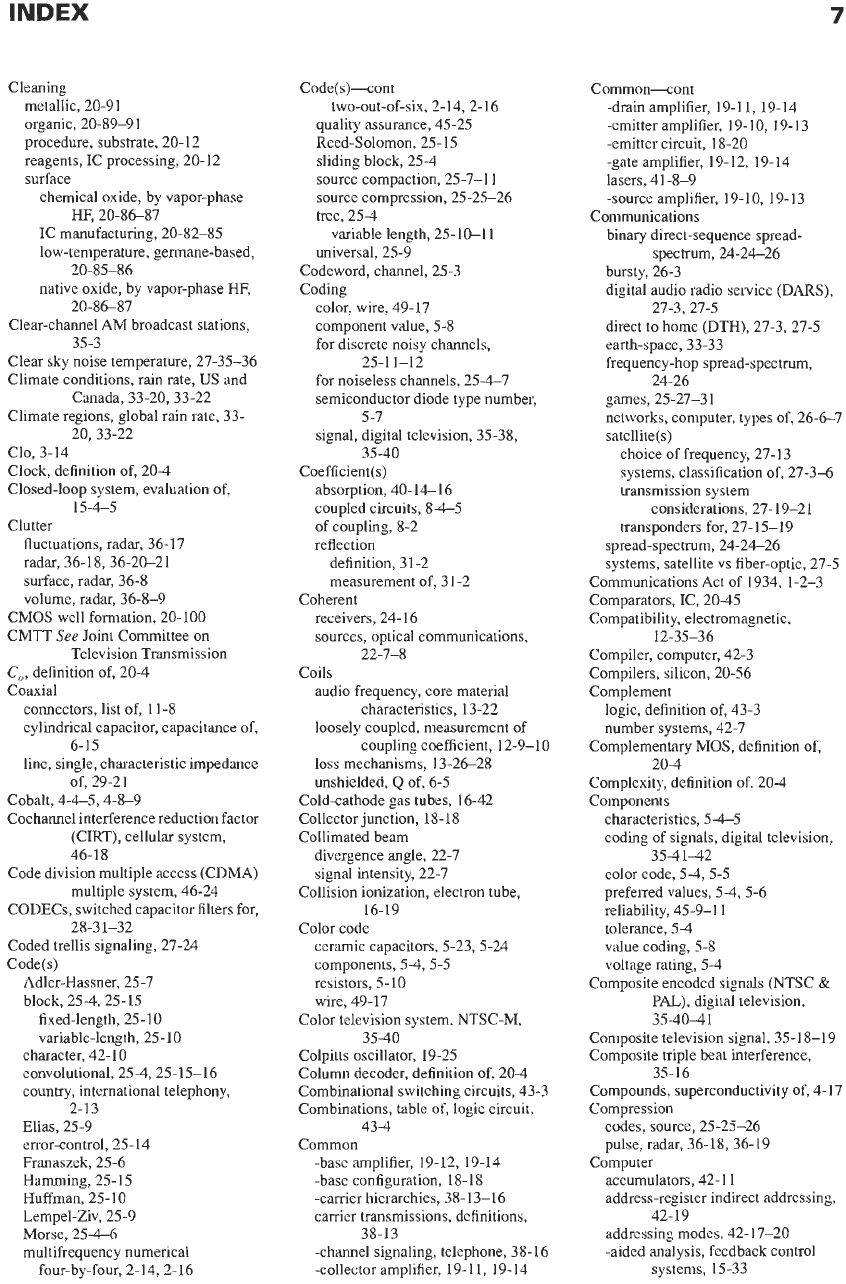
7
Cleaning
metallic, 20-91
organic, 20-89-91
procedure, substrate, 20-12
reagents, IC processing, 20-12
surface
chemical oxide, by vapor-phase
IC manufacturing, 20-82-85
low-temperature, germane-based,
native oxide, by vapor-phase HF,
Clear-channel AM broadcast stations,
Clear sky noise temperature, 27-35-36
Climate conditions, rain rate,
US
and
Climate regions, global rain rate, 33-
Clo, 3-14
Clock, definition of, 20-4
Closed-loop system, evaluation of,
15-4-5
Clutter
HF,
20-86-87
20-85-86
20-86-87
35-3
Canada, 33-20,33-22
20,33-22
fluctuations, radar, 36-17
radar, 36-18, 36-20-21
surface, radar, 36-8
volume, radar, 36-8-9
CMOS well formation, 20-100
CMTT
See
Joint Committee
on
C,,
definition of, 20-4
Coaxial
Television Transmission
connectors, list of, 11-8
cylindrical capacitor, capacitance of,
line, single, characteristic impedance
6-15
of, 29-21
Cobalt, 4-4-5,4-8-9
Cochannel interference reduction factor
(CIRT), cellular system,
46-18
Code division multiple access (CDMA)
multiple system, 46-24
CODECs, switched capacitor filters for,
28-31-32
Coded trellis signaling, 27-24
Code@)
Adler-Hassner, 25-7
block, 25-4,25-15
fixed-length, 25-10
variable-length, 25-10
character, 42-10
convolutional, 25-4,25-15-16
country, international telephony,
2-13
Elias, 25-9
error-control, 25-14
Franaszek, 25-6
Hamming, 25- 15
Huffman, 25-10
Lempel-Ziv, 25-9
Morse, 25-4-6
multifrequency numerical
four-by-four, 2-14,2-16
Code(s)-cont
two-out-of-six, 2-14,2-16
quality assurance, 45-25
Reed-Solomon, 25-15
sliding block, 25-4
source compaction, 25-7-1 1
source compression, 25-25-26
tree, 25-4
variable length, 25-10-1 1
universal, 25-9
Codeword, channel, 25-3
Coding
color, wire, 49-17
component value, 5-8
for discrete noisy channels,
for noiseless channels, 25-4-7
semiconductor diode type number,
25-11-12
5-7
signal, digital television, 35-38,
35-40
Coefficient(
s)
absorption, 40-14-16
coupled circuits, 8-4-5
reflection
of coupling, 8-2
definition, 3 1-2
measurement of, 31-2
Coherent
receivers, 24-16
sources, optical communications,
22-7-8
Coils
audio frequency, core material
loosely coupled, measurement of
loss mechanisms, 13-26-28
unshielded,
Q
of, 6-5
Cold-cathode gas tubes, 16-42
Collector junction, 18-18
Collimated beam
divergence angle, 22-7
signal intensity, 22-7
16-19
characteristics, 13-22
coupling coefficient, 12-9-10
Collision ionization, electron tube,
Color code
ceramic capacitors, 5-23,5-24
components, 5-4,5-5
resistors, 5-10
wire, 49-17
Color television system, NTSC-M,
35-40
Colpitts oscillator, 19-25
Column decoder, definition of, 20-4
Combinational switching circuits, 43-3
Combinations, table
of,
logic circuit,
Common
43-4
-base amplifier, 19-12, 19-14
-base configuration, 18-18
-carrier hierarchies, 38-13-16
carrier transmissions, definitions,
-channel signaling, telephone, 38-16
-collector amplifier, 19-11, 19-14
38-13
Common+ont
-drain amplifier, 19-1
1,
19-14
-emitter amplifier, 19-10, 19-13
-emitter circuit, 18-20
-gate amplifier, 19-12, 19-14
lasers, 41-8-9
-source amplifier, 19-10,19-13
Communications
binary direct-sequence spread-
spectrum, 24-24-26
bursty, 26-3
digital audio radio service (DARS),
direct to home (DTH), 27-3,27-5
earth-space, 33-33
frequency-bop spread-spectrum,
27-3,27-5
24-26
games, 25-27-31
networks, computer, types of, 26-6-7
satellite(s)
choice of frequency, 27-13
systems. classification
of,
27-3-6
transmission system
considerations, 27- 19-21
transponders for, 27-15-19
spread-spectrum, 24-24-26
systems, satellite vs fiber-optic, 27-5
Communications Act of 1934, 1-2-3
Comparators, IC, 20-45
Compatibility, electromagnetic,
Compiler, computer, 42-3
Compilers, silicon, 20-56
Complement
12-35-36
logic, definition of, 43-3
number systems, 42-7
Complementary MOS, definition of,
Complexity, definition of, 20-4
Components
20-4
characteristics, 5-4-5
coding of signals, digital television,
color code, 5-4,5-5
preferred values, 5-4,5-6
reliability, 45-9-1
1
tolerance, 5-4
value coding, 5-8
voltage rating, 5-4
35-41-42
Composite encoded signals (NTSC
&
PAL),
digital television,
35-4041
Composite television signal, 35-18-19
Composite triple beat interference,
Compounds, superconductivity of, 4-17
Compression
35-16
codes, source, 25-25-26
pulse, radar, 36-18,36-19
accumulators, 42-1 1
address-register indirect addressing,
42-19
addressing modes, 42-17-20
-aided analysis, feedback control
systems, 15-33
Computer
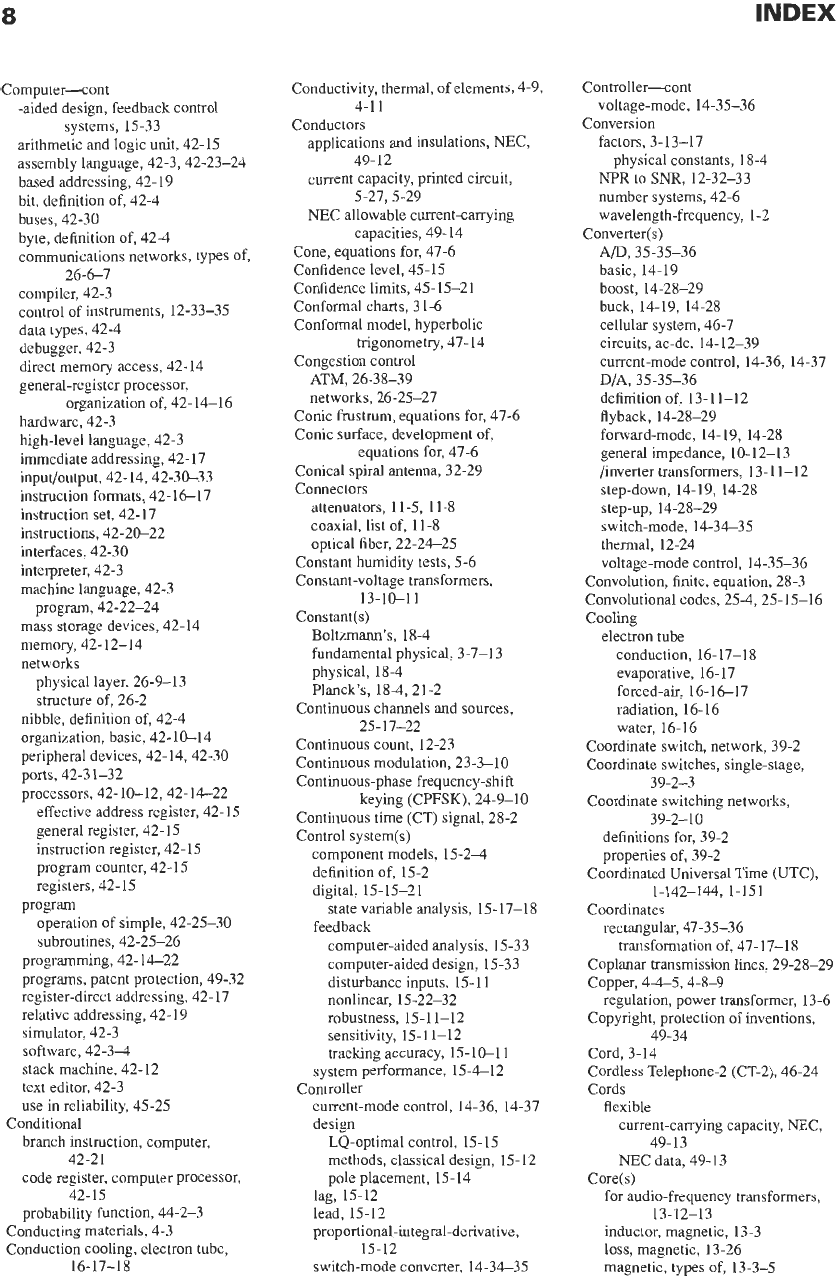
Computer-cont
-aided design, feedback control
arithmetic and logic unit, 42-15
assembly language, 42-3,42-23-24
based addressing, 42-19
bit, definition of, 42-4
buses, 42-30
byte, definition of, 42-4
communications networks, types of,
compiler, 42-3
control of instruments, 12-33-35
data types, 42-4
debugger, 42-3
direct memory access, 42-14
general-register processor,
hardware, 42-3
high-level language, 42-3
immediate addressing, 42-17
input/output, 42-14,42-30-33
instruction formats, 42-16-17
instruction set, 42-17
instructions, 42-20-22
interfaces, 42-30
interpreter, 42-3
machine language, 42-3
program, 42-22-24
mass storage devices, 42-14
memory, 42-12-14
networks
systems, 15-33
26-6-7
organization of, 42-14-16
physical layer, 26-9-13
structure of, 26-2
nibble, definition of, 42-4
organization, basic, 42-10-14
peripheral devices, 42-14,42-30
processors, 42-10-12,42-14-22
ports, 42-31-32
effective address register, 42-15
general register, 42-15
instruction register, 42-15
program counter, 42-15
registers, 42-15
operation of simple, 42-25-30
subroutines, 42-25-26
programming, 42-14-22
programs, patent protection, 49-32
register-direct addressing, 42- 17
relative addressing, 42-19
simulator, 42-3
software, 42-3-4
stack machine, 42-12
text editor, 42-3
use in reliability, 45-25
branch instruction, computer,
program
Conditional
42-21
code register, computer processor,
42-15
probability function, 44-2-3
Conducting materials, 4-3
Conduction cooling, electron tube,
16-17-18
Conductivity, thermal, of elements, 4-9,
Conductors
4-11
applications and insulations, NEC,
49-12
current capacity, printed circuit,
5-21,5-29
NEC allowable current-canying
capacities, 49-14
Cone, equations
for,
47-6
Confidence level, 45-15
Confidence limits, 45-15-21
Conformal charts, 31-6
Conformal model, hyperbolic
trigonometry, 47-14
Congestion control
ATM,
26-38-39
networks, 26-25-27
Conic frustrum, equations for, 47-6
Conic surface, development of,
equations for, 47-6
Conical spiral antenna, 32-29
Connectors
attenuators, 11-5, 11-8
coaxial, list of, 11-8
optical fiber, 22-24-25
Constant humidity tests, 5-6
Constant-voltage transformers,
13-10-11
Constant(s)
Boltzmann’s, 18-4
fundamental physical, 3-7-13
physical, 18-4
Planck’s, 18-4,21-2
Continuous channels and sources,
Continuous count, 12-23
Continuous modulation, 23-3-10
Continnous-phase frequency-shift
Continuous time (CT) signal, 28-2
Control system(s)
25- 11-22
keying (CPFSK), 24-9-10
component models, 15-2-4
definition of, 15-2
digital, 15-15-21
feedback
state variable analysis, 15-17-18
computer-aided analysis, 15-33
computer-aided design, 15-33
disturbance inputs, 15-1
1
nonlinear, 15-22-32
robustness, 15-11-12
sensitivity, 15-1 1-12
tracking accuracy, 15-10-1
1
system performance, 15-4-12
Controller
current-mode control, 14-36, 14-37
design
LQ-optimal control, 15-15
methods, classical design, 15-12
pole placement, 15-14
lag, 15-12
lead, 15-12
proportional-integral-derivative,
switch-mode converter, 14-3435
15-12
Controller--cont
Conversion
voltage-mode, 14-35-36
factors, 3-13-17
physical constants, 18-4
NPR
to
SNR,
12-32-33
number systems, 42-6
wavelength-frequency, 1-2
AD,
35-35-36
basic, 14-19
buck, 14-19, 14-28
cellular system, 46-7
circuits, ac-dc, 14-12-39
current-mode control, 14-36, 14-37
D/A,
35-35-36
definition of. 13-11-12
flyback, 14-28-29
forward-mode, 14-19, 14-28
general impedance, 10-12-13
/inverter transformers, 13-1 1-12
step-down, 14-19, 14-28
step-up, 14-28-29
switch-mode, 14-34-35
thermal, 12-24
voltage-mode control, 14-35-36
Convolution, finite, equation, 28-3
Convolutional codes, 25-4,25-15-16
Converter(
s)
boost, 14-28-29
Cooling
electron tube
conduction, 16-17-1 8
evaporative, 16- 17
forced-air, 16-16-17
radiation, 16-16
water, 16-16
Coordinate switch, network, 39-2
Coordinate switches, single-stage,
Coordinate switching networks,
39-2-3
39-2-10
definitions for, 39-2
properties of, 39-2
Coordinated Universal Time (UTC),
Coordinates
1-142-144, 1-151
rectangular, 47-35-36
transformation of, 47-17-18
Coplanar transmission lines, 29-28-29
Copper, 4-4-5,4-8-9
regulation, power transformer, 13-6
Copyright, protection of inventions,
Cord, 3-14
Cordless Telephone-2 (CT-2), 46-24
Cords
49-34
flexible
current-canying capacity, NEC,
49- 13
NEC data, 49-13
Core(
s)
for audio-frequency transformers,
13-12-13
inductor, magnetic, 13-3
loss, magnetic, 13-26
magnetic, types of, 13-3-5
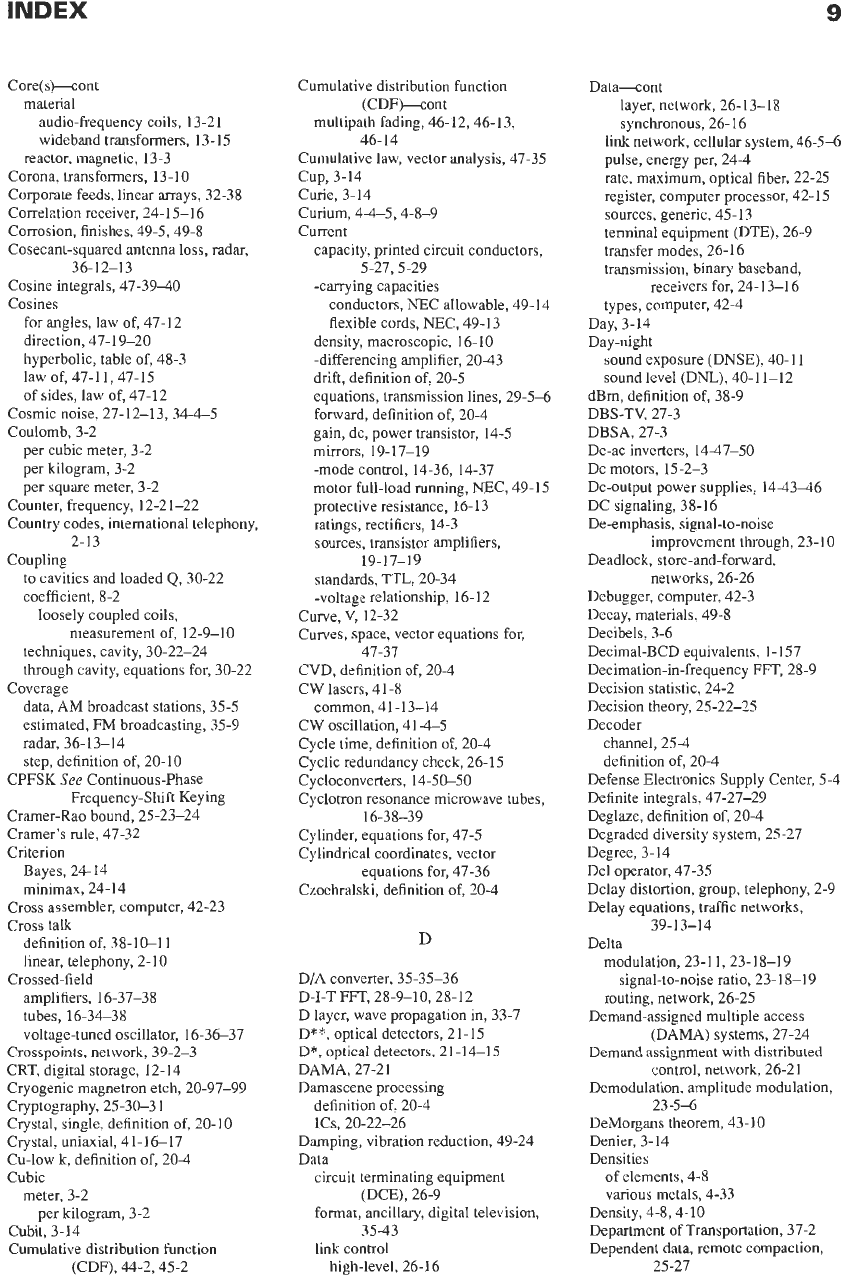
9
Core( s)-cont
material
audio-frequency coils, 13-21
wideband transformers, 13-15
reactor, magnetic, 13-3
Corona, transformers, 13-10
Corporate feeds, linear arrays, 32-38
Correlation receiver, 24-15-16
Corrosion, finishes, 49-5,49-8
Cosecant-squared antenna loss, radar,
36-12-13
Cosine integrals, 47-3940
Cosines
for angles, law of, 47-12
direction, 47-19-20
hyperbolic, table of, 48-3
law of, 47-11,47-15
of sides, law of, 47-12
Cosmic noise, 27-12-13,34-4-5
Coulomb, 3-2
per cubic meter, 3-2
per kilogram, 3-2
per square meter, 3-2
Counter, frequency, 12-21-22
Country codes, international telephony,
Coupling
2-13
to cavities and loaded
Q,
30-22
coefficient, 8-2
loosely coupled coils,
measurement of, 12-9-10
techniques, cavity, 30-22-24
through cavity, equations for, 30-22
data, AM broadcast stations, 35-5
estimated,
FM
broadcasting, 35-9
radar, 36-13-14
step, definition of, 20-10
CPFSK
See
Continuous-Phase
Cramer-Rao bound, 25-23-24
Cramer’s rule, 47-32
Criterion
Coverage
Frequency-Shift Keying
Bayes, 24-14
minimax, 24-14
Cross assembler, computer, 42-23
Cross talk
definition of, 38-10-1 1
linear, telephony, 2-10
amplifiers, 16-37-38
tubes, 16-34-38
voltage-tuned oscillator, 16-36-37
Crossed-field
Crosspoints, network, 39-2-3
CRT, digital storage, 12-14
Cryogenic magnetron etch, 20-97-99
Cryptography, 25-30-3
1
Crystal, single, definition
of,
20-10
Crystal, uniaxial, 41-16-17
Cu-low k, definition of, 20-4
Cubic
meter, 3-2
per kilogram, 3-2
Cubit, 3-14
Cumulative distribution function
(CDF), 44-2,452
Cumulative distribution function
(CDF)--cont
multipath fading, 46-l2,46-13,
46-14
Cumulative law, vector analysis, 47-35
Curie, 3-14
Curium, 4-4-5,4-8-9
Current
CUP, 3-14
capacity, printed circuit conductors,
-carrying capacities
5-27,5 -29
conductors, NEC allowable, 49-14
flexible cords, NEC, 49-13
density, macroscopic, 16-10
-differencing amplifier, 20-43
drift, definition of, 20-5
equations, transmission lines, 29-5-6
forward, definition of, 20-4
gain, dc, power transistor, 14-5
mirrors, 19-17-19
-mode control, 14-36, 14-37
motor full-load running, NEC, 49-15
protective resistance, 16-13
ratings, rectifiers, 14-3
sources, transistor amplifiers,
19-1 7-19
standards, TTL, 20-34
-voltage relationship, 16-12
Curve,
V,
12-32
Curves, space, vector equations for,
47-37
CVD, definition of, 20-4
CW lasers, 41-8
common, 41
-
13-14
CW oscillation, 41-4-5
Cycle time, definition of, 20-4
Cyclic redundancy check, 26-15
Cycloconverters, 14-50-50
Cyclotron resonance microwave tubes,
16-38-39
Cylinder, equations for, 47-5
Cylindrical coordinates, vector
Czochralski, definition of, 20-4
equations for, 47-36
D
D/A converter, 35-35-36
D-I-T
FFT,
28-9-10,28-12
D layer, wave propagation in, 33-7
D**, optical detectors, 21-15
D*,
optical detectors, 21-14-15
DAMA, 27-21
Damascene processing
definition
of,
20-4
ICs, 20-22-26
Damping, vibration reduction, 49-24
Data
circuit terminating equipment
format, ancillary, digital television,
link control
(DCE), 26-9
35-43
high-level, 26-16
Data-cont
layer, network, 26-13-18
synchronous, 26-16
link network, cellular system, 46-54
pulse, energy per, 24-4
rate, maximum, optical fiber, 22-25
register, computer processor, 42-15
sources, generic, 45-13
terminal equipment (DTE), 26-9
transfer modes, 26-16
transmission, binary baseband,
receivers for, 24-13-16
types, computer, 42-4
Day, 3-14
Day-night
sound exposure (DNSE), 40-1 1
sound level (DNL), 40-11-12
dBm, definition of, 38-9
DBSA, 27-3
Dc-ac inverters, 14-47-50
Dc motors, 15-2-3
Dc-output power supplies, 14-4346
DC signaling, 38-16
De-emphasis, signal-to-noise
improvement through, 23-10
Deadlock, store-and-forward,
networks, 26-26
Debugger, computer, 42-3
Decay, materials, 49-8
Decibels, 3-6
Decimal-BCD equivalents, 1-157
Decimation-in-frequency FFT, 28-9
Decision statistic, 24-2
Decision theory, 25-22-25
Decoder
DES-TV, 27-3
channel, 25-4
definition of, 20-4
Defense Electronics Supply Center, 5-4
Definite integrals, 47-27-29
Deglaze, definition
of,
20-4
Degraded diversity system, 25-27
Degree,
3-14
Del operator, 47-35
Delay distortion, group, telephony, 2-9
Delay equations, traffic networks,
Delta
39-13-14
modulation, 23-11, 23-18-19
routing, network, 26-25
signal-to-noise ratio, 23-18-19
Demand-assigned multiple access
(DAMA) systems, 27-24
Demand assignment with distributed
control, network, 26-21
Demodulation, amplitude modulation,
23-5-6
DeMorgans theorem, 43-10
Denier, 3-14
Densities
of
elements, 4-8
various
metals, 4-33
Density, 4-8,4-10
Department of Transportation, 37-2
Dependent data, remote compaction,
25-27
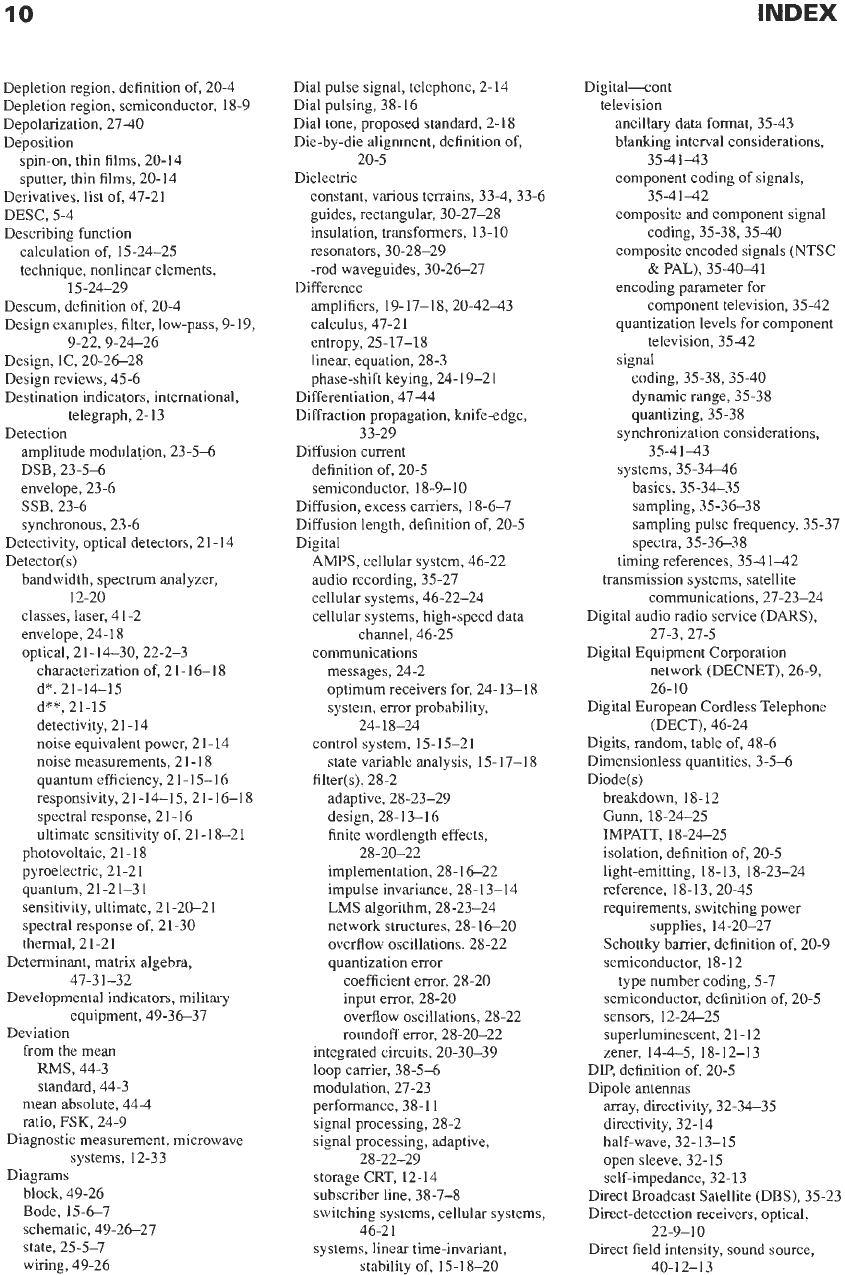
Depletion region, definition of, 20-4
Depletion region, semiconductor, 18-9
Depolarization, 27-40
Deposition
spin-on, thin films, 20-14
sputter, thin films, 20-14
Derivatives, list of, 47-21
Describing function
DESC, 5-4
calculation of, 15-24-25
technique, nonlinear elements.
15-24-29
Descum, definition of, 20-4
Design examples, filter, low-pass, 9-19,
Design, IC, 20-26-28
Design reviews, 45-6
Destination indicators, international,
telegraph, 2-13
Detection
amplitude modulation, 23-5-6
DSB, 23-5-6
envelope, 23-6
SSB, 23-6
synchronous, 23-6
9-22,9-24-26
Detectivity, optical detectors, 21-14
Detector(s)
bandwidth, spectrum analyzer,
classes, laser, 41-2
envelope, 24-18
optical, 21-14-30, 22-2-3
12-20
characterization of, 21-16-18
d*, 21-14-15
d**, 21-15
detectivity, 21-14
noise equivalent power, 21-14
noise measurements, 21-18
quantum efficiency, 21-15-16
responsivity, 21-14-15, 21-16-18
spectral response, 21-16
ultimate sensitivity of, 21-18-21
photovoltaic, 21-18
pyroelectric, 21-21
quantum, 2 1-2 1-3
1
sensitivity, ultimate, 21-20-21
spectral response of. 21-30
thermal, 21-21
Determinant, matrix algebra,
47-31-32
Developmental indicators, military
equipment, 49-36-37
Deviation
from the mean
RMS, 44-3
standard, 44-3
mean absolute, 44-4
ratio,
FSK,
24-9
Diagnostic measurement, microwave
Diagrams
systems, 12-33
block, 49-26
Bode, 15-6-7
schematic, 49-26-27
state, 25-5-7
wiring, 49-26
Dial pulse signal, telephone, 2-14
Dial pulsing, 38-16
Dial tone, proposed standard, 2-18
Die-by-die alignment, definition of,
Dielectric
20-5
constant, various terrains, 33-4,33-6
guides, rectangular, 30-27-28
insulation, transformers, 13-10
resonators, 30-28-29
-rod waveguides, 30-26-27
amplifiers, 19-17-18,20-4243
calculus, 47-21
entropy, 25-17-18
linear, equation, 28-3
phase-shift keying, 24-19-21
Difference
Differentiation, 47-44
Diffraction propagation, knife-edge,
Diffusion current
33-29
definition of, 20-5
semiconductor, 18-9-10
Diffusion, excess carriers, 18-6-7
Diffusion length, definition of, 20-5
Digital
AMPS, cellular system, 46-22
audio recording, 35-27
cellular systems, 46-22-24
cellular systems, high-speed data
communications
channel, 46-25
messages, 24-2
optimum receivers for, 24-13-18
system, error probability,
24- 18-24
control system, 15-15-21
filter(s), 28-2
state variable analysis, 15-17-18
adaptive, 28-23-29
design, 28-13-16
finite wordlength effects,
implementation, 28-1 6-22
impulse invariance, 28-13-14
LMS
algorithm, 28-23-24
network structures, 28-16-20
overflow oscillations, 28-22
quantization error
coefficient error, 28-20
input error, 28-20
overflow oscillations, 28-22
roundoff error, 28-20-22
28-20-22
integrated circuits, 20-30-39
loop carrier, 38-5-6
modulation, 27-23
performance, 38-1 1
signal processing, 28-2
signal processing, adaptive,
28-22-29
storage CRT, 12-14
subscriber line, 38-7-8
switching systems, cellular systems,
systems, linear time-invariant,
46-21
stability of, 15-18-20
Digital-cont
television
ancillary data format, 35-43
blanking interval considerations,
component coding of signals,
composite and component signal
composite encoded signals (NTSC
encoding parameter for
component television, 35-42
quantization levels for component
television, 35-42
signal
coding, 35-38,35-40
dynamic range. 35-38
quantizing, 35-38
35-4143
35-4142
coding, 35-38,35-40
&
PAL),
35-4041
synchronization considerations,
35-4143
systems, 35-34-46
basics, 35-34-35
sampling, 35-36-38
sampling pulse frequency, 35-37
spectra, 35-36-38
timing references, 35-4142
transmission systems, satellite
communications, 27-23-24
Digital audio radio service (DARS),
27-3, 27-5
Digital Equipment Corporation
network (DECNET), 26-9,
Digital European Cordless Telephone
Digits, random, table of, 48-6
Dimensionless quantities, 3-54
Diode(s)
26-10
(DECT), 46-24
breakdown, 18-12
Gunn,
18-2425
IMPATT, 18-24-25
isolation, definition of, 20-5
light-emitting, 18-13, 18-23-24
reference, 18-13,20-45
requirements, switching power
Schottky barrier, definition of, 20-9
semiconductor, 18-
12
semiconductor, definition of, 20-5
sensors, 12-24-25
superluminescent, 21 -12
zener, 14-4-5, 18-12-13
supplies, 14-20-27
type number coding, 5-7
DIP, definition of, 20-5
Dipole antennas
array, directivity, 32-34-35
directivity, 32-14
half-wave, 32-13-15
open sleeve, 32-15
self-impedance, 32-13
Direct Broadcast Satellite (DBS), 35-23
Direct-detection receivers, optical,
Direct field intensity, sound source,
22-9-10
40-12-1 3
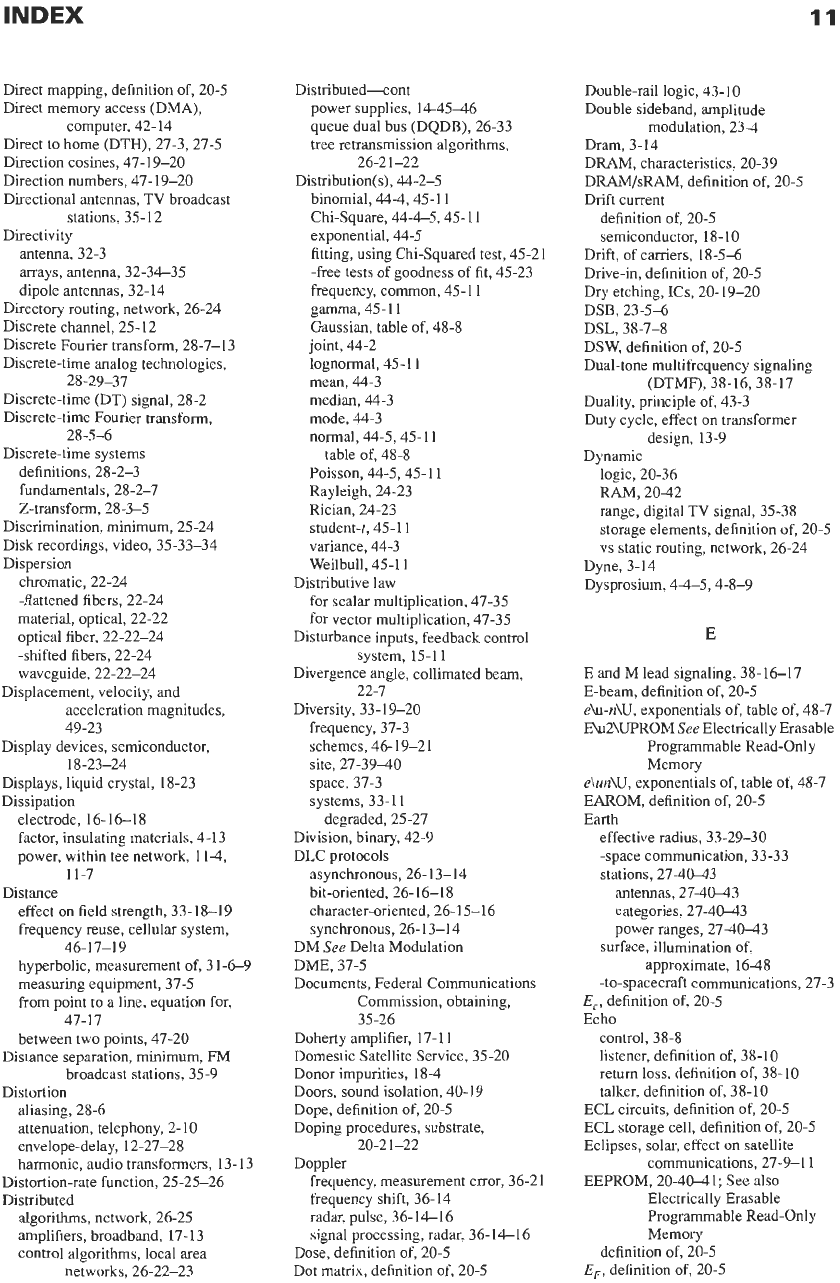
Direct mapping, definition of, 20-5
Direct memory access (DMA),
computer, 42-14
Direct to home (DTH), 27-3,27-5
Direction cosines, 47-19-20
Direction numbers, 47-19-20
Directional antennas, TV broadcast
stations, 35-12
Directivity
antenna, 32-3
arrays, antenna, 32-34-35
dipole antennas, 32-14
Directory routing, network, 26-24
Discrete channel, 25-12
Discrete Fourier transform, 28-7-13
Discrete-time analog technologies,
Discrete-time (DT) signal, 28-2
Discrete-time Fourier transform,
Discrete-time systems
definitions, 28-2-3
fundamentals, 28-2-7
28-29-37
28-5-6
Z-transform, 28-3-5
Discrimination, minimum, 25-24
Disk recordings, video, 35-33-34
Dispersion
chromatic, 22-24
-flattened fibers, 22-24
material, optical, 22-22
optical fiber, 22-22-24
-shifted fibers, 22-24
waveguide, 22-22-24
Displacement, velocity, and
acceleration magnitudes,
49-23
Display devices, semiconductor,
18-23-24
Displays, liquid crystal, 18-23
Dissipation
electrode, 16- 16-1 8
factor, insulating materials, 4-1 3
power, within tee network, 11-4,
11-7
Distance
effect
on
field strength, 33-18-19
frequency reuse, cellular system,
hyperbolic, measurement of, 31-6.
measuring equipment, 37-5
from point to a line, equation for,
between two points, 47-20
46-17-19
47-17
Distance separation, minimum,
FM
Distortion
broadcast stations, 35-9
aliasing, 28-6
attenuation, telephony, 2-10
envelope-delay, 12-27-28
harmonic, audio transformers, 13-
Distortion-rate function, 25-25-26
Distributed
algorithms, network, 26-25
amplifiers, broadband, 17-13
control algorithms, local area
networks, 26-22-23
Distributed-cont
power supplies, 14-4546
queue dual bus (DQDB), 26-33
tree retransmission algorithms,
26-21-22
Distribution(s), 44-2-5
binomial, 44-4,45-11
Chi-square, 44-4-5,45-11
exponential, 44-5
fitting, using Chi-Squared test, 45-21
-free tests of goodness
of
fit, 45-23
frequency, common, 45-1
1
gamma, 45-1 1
Gaussian, table of, 48-8
joint, 44-2
lognormal, 45-11
mean, 44-3
medmn, 44-3
mode, 44-3
normal, 44-5,45-11
table of, 48-8
Poisson, 44-5,45-11
Rayleigh, 24-23
Rician, 24-23
student-t, 45-1
1
variance, 44-3
Weilbull, 45-1 1
Distributive law
for scalar multiplication, 47-35
for vector multiplication, 47-35
Disturbance inputs, feedback control
Divergence angle, collimated beam,
Diversity, 33-19-20
frequency, 37-3
schemes, 46-19-21
site, 27-3940
space, 37-3
systems, 33-11
system, 15-11
22-7
degraded, 25-27
Division, binary, 42-9
DLC protocols
asynchronous, 26-13-14
bit-oriented, 26-16-18
character-oriented, 26-15-16
synchronous, 26- 13-14
DM
See
Delta Modulation
Documents, Federal Communications
-9 DME, 37-5
Commission, obtaining,
35-26
Doherty amplifier, 17-11
Domestic Satellite Service, 35-20
Donor impurities, 18-4
Doors, sound isolation, 40-19
Dope, definition of, 20-5
Doping procedures, substrate,
20-21-22
13 Doppler
frequency, measurement error, 36-21
frequency shift, 36-14
radar, pulse, 36-14-16
signal processing, radar, 36-14-16
Dose, definition of, 20-5
Dot matrix, definition of, 20-5
Double-rail logic, 43-10
Double sideband, amplitude
Dram, 3-14
DRAM, characteristics, 20-39
DRAM/sRAM, definition of, 20-5
Drift current
modulation, 23-4
definition of, 20-5
semiconductor, 18-10
Drift, of carriers, 18-5-6
Drive-in, definition of, 20-5
Dry etching, ICs, 20-19-20
DSB, 23-54
DSL, 38-7-8
DSW, definition of, 20-5
Dual-tone multifrequency signaling
(DTMF), 38-16, 38-17
Duality, principle of, 43-3
Duty cycle, effect on transformer
design, 13-9
Dynamic
logic, 20-36
RAM,
20-42
range, digital TV signal, 35-38
storage elements, definition of, 20-5
vs static routing, network, 26-24
Dyne, 3-14
Dysprosium, 4-&5,4-8-9
E
E and M lead signaling, 38-16-17
E-beam, definition of, 20-5
e\u-n\U,
exponentials of, table of, 48-7
&2\UPROM
See
Electrically Erasable
Programmable Read-only
Memory
eLn\U, exponentials of, table of, 48-7
EAROM, definition of, 20-5
Earth
effective radius, 33-29-30
-space communication, 33-33
stations, 27-40-43
antennas, 27-4043
categories, 27-40-43
power ranges, 27-40-43
surface, illumination of,
approximate, 16-48
-to-spacecraft communications, 27-3
E,,
definition of, 20-5
Echo
control, 38-8
listener, definition
of,
38-10
return
loss,
definition of, 38-10
talker, definition of, 38-10
ECL circuits, definition of, 20-5
ECL storage cell, definition of, 20-5
Eclipses, solar, effect on satellite
communications, 27-9-1
1
EEPROM, 20-4041;
See
also
Electrically Erasable
Programmable Read-only
Memory
definition of, 20-5
EF,
definition of, 20-5
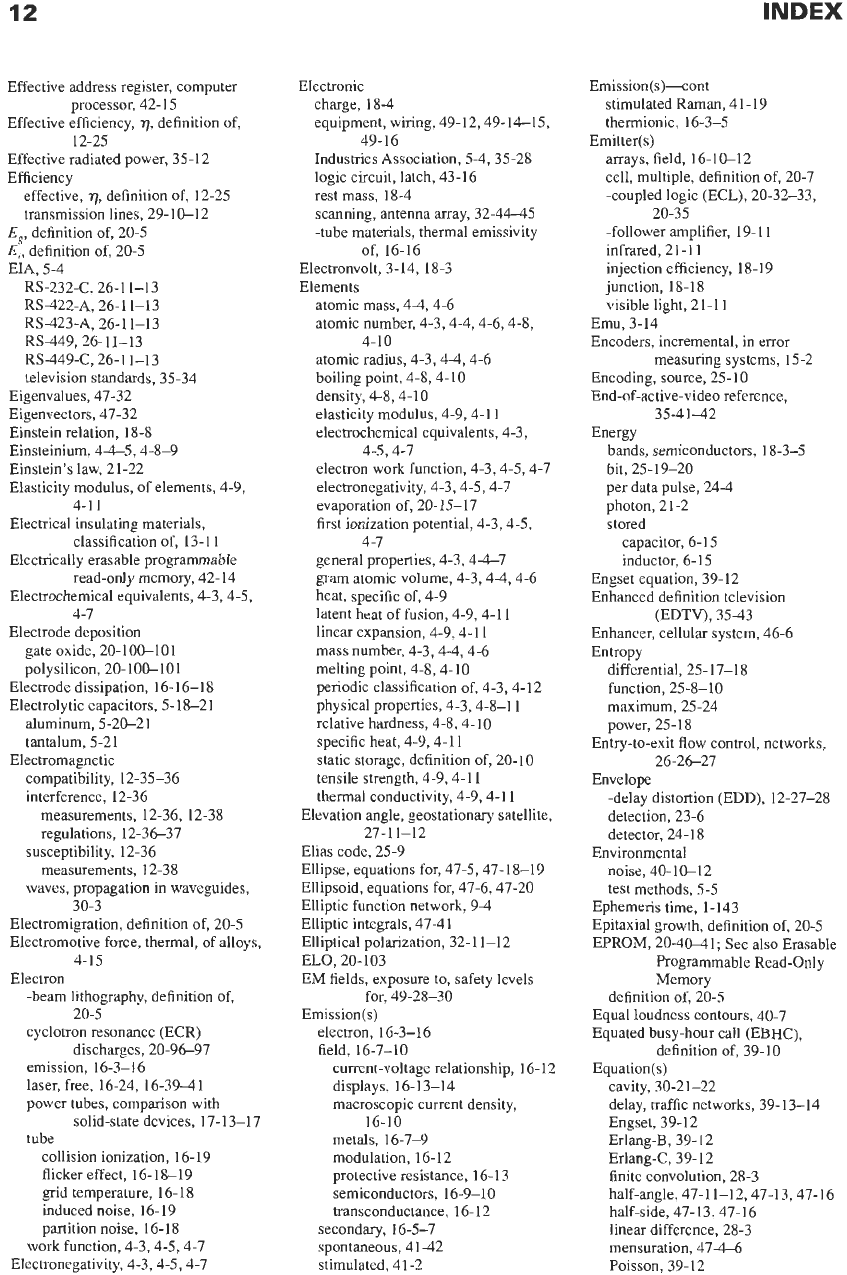
Effective address register, computer
processor, 42-15
Effective efficiency,
7,
definition of,
12-25
Effective radiated power, 35-12
Efficiency
effective,
7,
definition of, 12-25
transmission lines, 29-10-12
E8,
definition of, 20-5
E,,
definition of, 20-5
EIA, 5-4
RS-232-C. 26-11-13
RS-422-A, 26-11-13
RS-423-A, 26-11-13
RS-449,26-11-13
RS-449-C, 26-11-13
television standards, 35-34
Eigenvalues, 47-32
Eigenvectors, 47-32
Einstein relation, 18-8
Einsteinium, 4-4-5,4-8-9
Einstein’s law, 21-22
Elasticity modulus, of elements, 4-9,
4-1
1
Electrical insulating materials,
classification of, 13-1
1
Electrically erasable programmable
read-only memory, 42-14
Electrochemical equivalents, 4-3,4-5,
4-7
Electrode deposition
gate oxide, 20-100-101
polysilicon, 20-100-101
Electrode dissipation, 16-16-18
Electrolytic capacitors, 5-18-21
aluminum, 5-20-21
tantalum, 5-21
Electromagnetic
compatibility, 12-35-36
interference, 12-36
measurements, 12-36, 12-38
regulations, 12-36-37
measurements, 12-38
susceptibility, 12-36
waves, propagation in waveguides,
30-3
Electromigration, definition of, 20-5
Electromotive force, thermal, of alloys,
Electron
4-15
-beam
lithography, definition of,
cyclotron resonance (ECR)
emission, 16-3-16
laser, free, 16-24, 16-39-41
power tubes, comparison with
tube
20-5
discharges, 20-96-97
solid-state devices, 17-13-17
collision ionization, 16-19
flicker effect, 16-18-19
grid temperature, 16-18
induced noise, 16-19
partition noise, 16-18
work function, 4-3,4-5,4-7
Electronegativity, 4-3,4-5,4-7
Electronic
charge, 18-4
equipment, wiring, 49-12,49-14-15,
Industries Association, 5-4, 35-28
logic circuit, latch, 43-16
rest mass, 18-4
scanning, antenna array, 32-4445
-tube materials, thermal emissivity
49-16
of, 16-16
Electronvolt, 3-14, 18-3
Elements
atomic mass, 4-4,4-6
atomic number, 4-3,4-4,4-6,443,
atomic radius, 4-3,4-4,4-6
boiling point, 4-8,4-10
density, 4-8,4-10
elasticity modulus, 4-9,4-11
electrochemical equivalents, 4-3,
electron work function, 4-3,4-5,4-7
electronegativity, 4-3,4-5,4-7
evaporation of, 20-15-17
first ionization potential, 4-3,4-5,
general properties, 4-3,4-4-7
gram atomic volume, 4-3,4-4,4-6
heat, specific of, 4-9
latent heat of fusion, 4-9, 4-1 1
linear expansion, 4-9,4-11
mass number, 4-3,4-4, 4-6
melting point, 4-8,4-10
periodic classification of, 4-3,4-12
physical properties, 4-3,4-8-11
relative hardness, 4-8, 4-10
specific heat, 4-9,4-11
static storage, definition of, 20-10
tensile strength, 4-9,4-11
thermal conductivity, 4-9,4-11
4-10
4-5,4-7
4-7
Elevation angle, geostationary satellite,
Elias code, 25-9
Ellipse, equations for, 47-5,47-18-19
Ellipsoid, equations for, 47-6,47-20
Elliptic function network, 9-4
Elliptic integrals, 47-41
Elliptical polarization, 32-1 1-12
EM fields, exposure to, safety levels
Emission(
s)
27-11-12
ELO, 20-103
for, 49-28-30
electron, 16-3-16
field, 16-7-10
current-voltage relationship, 16-12
displays, 16-13-14
macroscopic current density,
metals, 16-7-9
modulation, 16-12
protective resistance, 16-1
3
semiconductors, 16-9-10
transconductance, 16-12
16-10
secondary, 16-5-7
spontaneous, 41-42
stimulated, 41-2
Emission(s)-cont
stimulated Raman, 41-19
thermionic, 16-3-5
arrays, field, 16-10-12
cell, multiple, definition of, 20-7
-coupled logic
(ECL),
20-32-33,
-follower amplifier, 19-1
1
infrared, 21-11
injection efficiency, 18-19
junction, 18-18
visible light, 21-11
Emitter(
s)
20-35
Emu, 3-14
Encoders, incremental, in error
Encoding, source, 25-10
End-of-active-video reference,
Energy
measuring systems, 15-2
35-41-42
bands, semiconductors, 18-3-5
bit, 25-19-20
per data pulse, 24-4
photon, 21-2
stored
capacitor, 6-15
inductor, 6-15
Engset equation, 39-12
Enhanced definition television
Enhancer, cellular system, 46-6
Entropy
(EDTV), 35-43
differential, 25-17-18
function, 25-8-10
maximum, 25-24
power, 25-18
Entry-to-exit flow control, networks,
Envelope
26-26-27
-delay distortion (EDD), 12-27-28
detection, 23-6
detector, 24-18
noise, 40-10-12
test methods, 5-5
Ephemeris time, 1-143
Epitaxial growth, definition of, 20-5
EPROM, 20-4041;
See
also Erasable
Programmable Read-only
Memory
Equal loudness contours, 40-7
Equated busy-hour call (EBHC),
Equation(s)
Environmental
definition of, 20-5
definition of, 39-10
cavity, 30-21-22
delay, traffic networks, 39-13-14
Engset, 39-12
Erlang-E, 39-12
Erlang-C, 39-12
finite convolution, 28-3
half-angle, 47-11-12,47-13,47-16
half-side, 47-13,47-16
linear difference, 28-3
mensuration, 47-46
Poisson, 39-12
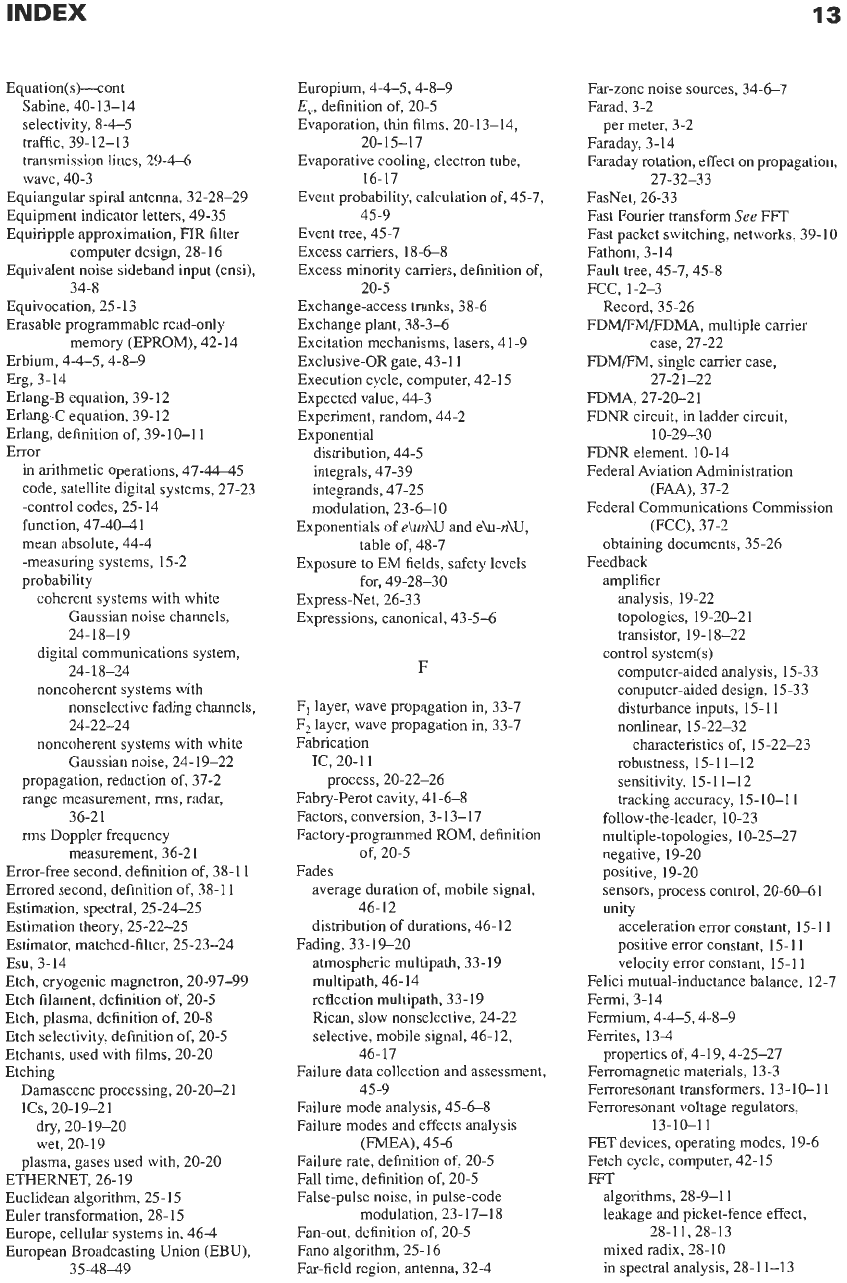
13
Equation(s)--cont
Sabine, 40-13-14
selectivity, 8-4-5
traffic, 39-12-13
transmission lines, 29-46
wave, 40-3
Equiangular spiral antenna, 32-28-29
Equipment indicator letters, 49-35
Equiripple approximation, FIR filter
computer design, 28-16
Equivalent noise sideband input (ensi),
34-8
Equivocation, 25-1 3
Erasable programmable read-only
Erbium, 4-4-5,4-8-9
Erg, 3-14
Erlang-B equation, 39-12
Erlang-C equation, 39-12
Erlang, definition of, 39-10-1 1
Error
memory (EPROM), 42-14
in arithmetic operations, 47-44-45
code, satellite digital systems, 27-23
-control codes, 25-14
function, 47-40-41
mean absolute, 44-4
-measuring systems, 15-2
probability
coherent systems with white
Gaussian noise channels,
24-18-19
digital communications system,
noncoherent systems with
24-18-24
nonselective fading channels,
24-22-24
Gaussian noise, 24-19-22
noncoherent systems with white
propagation, reduction of, 37-2
range measurement, rms, radar,
rms
Doppler frequency
36-21
measurement, 36-21
Error-free second, definition of, 38-1
1
Errored second, definition of, 38-1
1
Estimation, spectral, 25-24-25
Estimation theory, 25-22-25
Estimator, matched-filter, 25-23-24
Esu, 3-14
Etch, cryogenic magnetron, 20-97-99
Etch filament, definition
of,
20-5
Etch, plasma, definition of, 20-8
Etch selectivity, definition of, 20-5
Etchants,
used
with films, 20-20
Etching
Damascene processing, 20-20-21
ICs, 20-19-21
dry, 20-19-20
wet, 20-19
plasma, gases used with, 20-20
ETHERNET, 26-19
Euclidean algorithm, 25-15
Euler transformation, 28-15
Europe, cellular systems in, 46-4
European Broadcasting
Union
(EBU),
35-48-49
Europium, 4-4-5,4-8-9
E,,
definition of, 20-5
Evaporation, thin films, 20-1 3-14,
Evaporative cooling, electron tube,
16-17
Event probability, calculation of, 45-7,
45-9
Event tree, 45-7
Excess carriers, 18-6-8
Excess minority carriers, definition of,
Exchange-access trunks, 38-6
Exchange plant, 38-36
Excitation mechanisms, lasers, 41-9
Exclusive-OR gate, 43-1
1
Execution cycle, computer, 42-15
Expected value, 44-3
Experiment, random, 44-2
Exponential
20-15-17
20-5
distribution, 44-5
integrals, 47-39
integrands, 47-25
modulation, 23 -6-1
0
table of, 48-7
for, 49-28-30
Exponentials of
e\un\U
and
e\u-n\U,
Exposure to EM fields, safety levels
Express-Net, 26-33
Expressions, canonical, 43-5-6
F
F, layer, wave propagation in, 33-7
F, layer, wave propagation in, 33-7
Fabrication
IC, 20-11
process, 20-22-26
Fabry-Perot cavity, 41 -6-8
Factors, conversion, 3-13-17
Factory-programmed ROM, definition
of,
20-5
Fades
average duration of, mobile signal,
distribution of durations, 46-12
atmospheric multipath, 33-19
multipath, 46-14
reflection multipath, 33-19
Rican, slow nonselective, 24-22
selective, mobile signal, 46-12,
46-12
Fading, 33-19-20
46-17
45-9
Failure data collection and assessment,
Failure mode analysis, 45-6-8
Failure modes and effects analysis
(FMEA), 45-6
Failure rate, definition
of,
20-5
Fall time, definition of, 20-5
False-pulse noise, in pulse-code
modulation, 23- 17-18
Fan-out, definition of, 20-5
Fano algorithm, 25-16
Far-field region, antenna, 32-4
Far-zone noise sources, 34-6-7
Farad, 3-2
Faraday, 3-14
Faraday rotation, effect
on
propagation,
FasNet, 26-33
Fast Fourier transform
See
FFT
Fast packet switching, networks, 39-10
Fathom, 3-14
Fault tree, 45-7,454
FCC, 1-2-3
FDMFMIFDMA, multiple carrier
case, 27-22
FDMFM, single carrier case,
per meter, 3-2
27-32-33
Record, 35-26
27-21-22
FDMA, 27-20-2
1
FDNR circuit, in ladder circuit,
FDNR element, 10-14
Federal Aviation Administration
(FAA), 37-2
Federal Communications Commission
(FCC), 37-2
obtaining documents, 35-26
amplifier
10-29-30
Feedback
analysis, 19-22
topologies, 19-20-21
transistor, 19-18-22
computer-aided analysis, 15-33
computer-aided design, 15-33
disturbance inputs, 15-11
nonlinear, 15-22-32
robustness, 15-11-12
sensitivity, 15-1 1-12
tracking accuracy, 15-10-1
1
follow-the-leader, 10-23
multiple-topologies, 10-25-27
negative, 19-20
positive, 19-20
sensors, process control, 20-60-61
unity
control system(s)
characteristics of, 15-22-23
acceleration error constant, 15-1 1
positive error constant, 15-11
velocity error constant, 15-1
1
Felici mutual-inductance balance, 12-7
Fermi, 3-14
Fermium, 4-45,443-9
Ferrites, 13-4
properties
of,
4-19,4-25-27
Ferromagnetic materials, 13-3
Ferroresonant transformers, 13-10-11
Ferroresonant voltage regulators,
13-10-11
FET devices, operating modes, 19-6
Fetch cycle, computer, 42-15
FFT
algorithms, 28-9-1 1
leakage and picket-fence effect,
28-11,28-13
mixed radix, 28-10
in spectral analysis, 28-11-13
